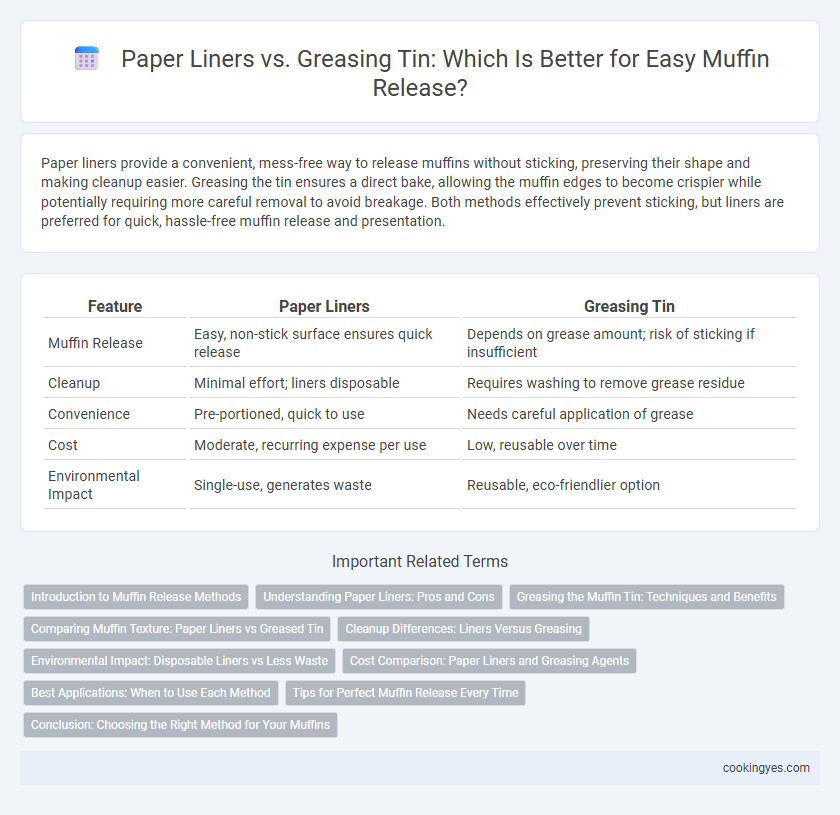Paper liners provide a convenient, mess-free way to release muffins without sticking, preserving their shape and making cleanup easier. Greasing the tin ensures a direct bake, allowing the muffin edges to become crispier while potentially requiring more careful removal to avoid breakage. Both methods effectively prevent sticking, but liners are preferred for quick, hassle-free muffin release and presentation.
Table of Comparison
| Feature | Paper Liners | Greasing Tin |
|---|---|---|
| Muffin Release | Easy, non-stick surface ensures quick release | Depends on grease amount; risk of sticking if insufficient |
| Cleanup | Minimal effort; liners disposable | Requires washing to remove grease residue |
| Convenience | Pre-portioned, quick to use | Needs careful application of grease |
| Cost | Moderate, recurring expense per use | Low, reusable over time |
| Environmental Impact | Single-use, generates waste | Reusable, eco-friendlier option |
Introduction to Muffin Release Methods
Paper liners provide a convenient, mess-free muffin release by preventing batter from sticking to the pan, ensuring easy removal and maintaining muffin shape. Greasing the tin with butter or oil creates a non-stick surface, promoting even baking and a slightly crisp edge on the muffin's base. Both methods enhance muffin presentation and texture, but paper liners offer added benefits for cleanup and portion control.
Understanding Paper Liners: Pros and Cons
Paper liners simplify muffin release by preventing direct contact with the tin, reducing cleanup time and preserving the muffin's shape. They also offer advantages like portion control, enhanced presentation, and easy portability while absorbing some moisture, which can affect muffin texture. However, paper liners increase waste and may alter crust crispness compared to greasing the tin, which can provide a more uniform bake and reduce environmental impact.
Greasing the Muffin Tin: Techniques and Benefits
Greasing the muffin tin with butter, oil, or non-stick spray creates a thin, even layer that facilitates easy muffin release and promotes a golden, crisp edge. Techniques such as using a pastry brush or paper towel ensure thorough coverage in each cup, preventing sticking and maintaining the muffin's shape. This method reduces waste by eliminating the need for liners and enhances the texture and appearance of homemade muffins.
Comparing Muffin Texture: Paper Liners vs Greased Tin
Using paper liners for muffins often results in a moister texture by trapping steam during baking, while greasing the tin can promote a slightly crisper exterior due to direct fat contact. Paper liners create a barrier that prevents muffins from drying out, preserving tenderness and crumb structure, whereas greasing the tin may allow edges to caramelize and develop a firmer crust. Texture preference depends on desired muffin qualities, with liners favoring softness and greasing enhancing crispness.
Cleanup Differences: Liners Versus Greasing
Paper liners simplify cleanup by containing crumbs and preventing batter from sticking to the muffin tin, reducing the need for scrubbing. Greasing the tin requires thorough washing and scraping to remove residue, increasing cleanup time and effort. Using liners often leads to faster, more convenient cleanup and extends the lifespan of muffin tins by minimizing direct contact with fats and sugars.
Environmental Impact: Disposable Liners vs Less Waste
Paper liners for muffins generate significant disposable waste, contributing to increased landfill burden and resource consumption. Greasing tins reduces waste by eliminating the need for single-use liners, promoting sustainability through reusable bakeware. Choosing greased tins supports lower environmental impact by minimizing paper products and reducing the carbon footprint associated with liner production and disposal.
Cost Comparison: Paper Liners and Greasing Agents
Paper liners typically cost between $0.01 to $0.03 per liner, making them a more expensive option compared to traditional greasing agents such as butter, oil, or cooking spray, which generally cost around $0.005 to $0.01 per use. While paper liners reduce cleanup time and prevent sticking effectively, greasing tins is more cost-efficient for large batch baking due to lower material expenses. The choice depends on prioritizing convenience and presentation versus minimizing per-unit baking costs.
Best Applications: When to Use Each Method
Paper liners provide an excellent non-stick surface ideal for delicate muffins or when easy cleanup is a priority, making them perfect for cupcakes and moist, sticky batters. Greasing the tin is best suited for muffins with thicker, firmer batters or those that develop a crusty exterior, ensuring a golden, crisp bottom and edges. Choose paper liners for convenience and presentation, while greased tins deliver superior texture and browning in muffins requiring direct heat contact.
Tips for Perfect Muffin Release Every Time
Using paper liners ensures easy muffin release by preventing sticking and retaining moisture for soft, tender crumbs. When opting to grease the tin, apply a thin, even layer of butter or non-stick spray, focusing on corners to avoid uneven browning. Cooling muffins briefly before removal further aids in maintaining shape and achieving perfect release every time.
Conclusion: Choosing the Right Method for Your Muffins
Paper liners offer a convenient and mess-free way to release muffins, preserving their shape and making cleanup easier. Greasing the tin provides a crispier muffin crust and allows for direct contact with the heat, enhancing browning and texture. Selecting between paper liners and greasing depends on priorities like ease of cleanup, muffin texture, and presentation preferences.
Paper liners vs greasing tin for muffin release Infographic

 cookingyes.com
cookingyes.com